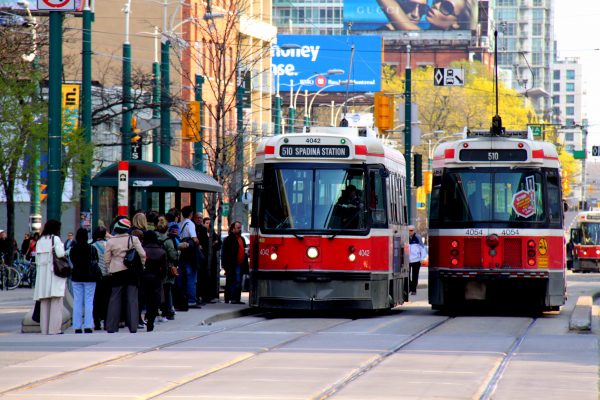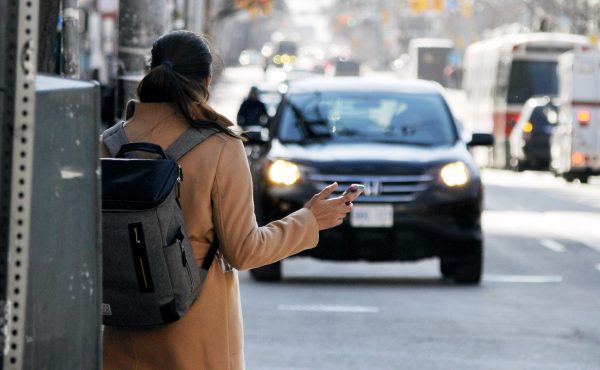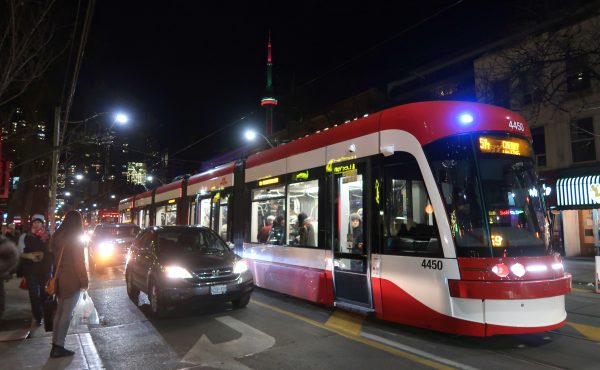Whether or not you like Ontario Premier Doug Ford’s transit plan for the GTA, none of it is going to help us anytime soon. Its nearly $29 billion in new capital projects, which are mostly underground, some maybe elevated, won’t be realized for at least a decade.
Meantime, we’re stuck dealing with subway overcrowding, transit lines at or over capacity, buses and streetcars jammed in mixed traffic throughout the city. Obviously, this is not a good scenario, for reasons from economy to environment to livability.
To keep our city moving, we need near-term solutions for transit while we wait for Ontario’s megaprojects to materialize. They should be quick to deploy, and relatively inexpensive, given that the City of Toronto’s budget is strained making up the shortfall from recent Provincial cuts and undelivered gas tax revenue earmarked for TTC maintenance. (Not to mention that we don’t yet know how much Toronto will be on the hook to pay for its contribution to Ford’s transit plan.)
At the Ryerson City Building Institute, we believe a big opportunity lies in improving and innovating Toronto’s existing surface transit. Our street-level transit grid has the potential for heavier lifting to move riders all over the city…if we make some serious tweaks.
On July 30, we’re hosting a free morning event “Hacking Surface Transit in Toronto,” to explore feasible options with a panel of experts. To start the conversation, here are some ideas.
Scale innovations citywide
It’s not like Toronto hasn’t been working to improve its surface transit routes: the St. Clair streetcar right-of-way and the recent King Street Transit Pilot are great examples of innovating existing streetcar routes to ease congestion and boost ridership. The St. Clair project cost a total of $106 million and significantly reduced travel times and boosted ridership, but suffered from scope creep which increased costs and completion times – providing lessons for future application.
The super-quick King Pilot project transformed a segment of a busy downtown streetcar route into a reliable corridor freed from mixed traffic, an absolute bargain of a hack at an estimated $1.2 million/km compared to the $500 to $800 million/km cost to build underground transit.
Is there the option to extend King Street’s transit priority along the entirety of its route, which carries over 80,000 riders per day – two thirds more people than the Sheppard subway?
Concerns raised over such a proposal question whether the parallel network of streets beyond Bathurst and Jarvis can absorb east-west vehicle volumes redirected from King. But if we can’t get people comfortably out of cars and onto frequent and reliable transit (not to mention bicycles), we’ll lock people into car dependency – notably condo dwellers along densely developed King and in Liberty Village – and exacerbate our transportation problems.
With Toronto’s downtown residential population expected to double in the coming decades, and currently experiencing the region’s greatest employment growth, the time is now to get serious about mode shift in North America’s fourth largest metropolis.
A broader proposal: could we scale the King Street model across the city, hacking other busy Toronto streetcar routes into rapid transit?
Advance electric BRTs
Since Toronto’s budget is likely not in a position to fund LRT routes, we might look to Bus Rapid Transit (BRT). Many of the city’s suburban bus lines and previous Transit City proposed LRTs are on arterials (for example, Jane Street and Malvern Avenue) that are suitable for mid-lane BRTs.
There is a long list of busway advantages and benefits. BRTs are at least 50% less costly than LRTs to create, and take half the time to build. They can be efficiently converted into LRTs by adding rail infrastructure, if capacity so dictates. They contribute positively to the revitalization of neighbourhoods through raising the potential for transit-oriented development and affordable housing, and in the case of certain routes, provide rapid transit to underserved priority neighbourhoods.
Now that the TTC is trialing a new electric fleet, we have an opportunity for emissions-free BRT. EV technology is growing in leaps and bounds; while today’s electric buses can act as mobile storage batteries charged overnight with surplus baseload electricity, future tech will reduce dependence on the grid altogether with self-powered solar vehicles.
Find new ways of paying for innovation
Obviously, nothing comes for free. So how do we pay for these innovations? Toronto’s budget is already overstretched; new sources of revenue are required. Toronto, Metrolinx and the Province have studied and debated revenue tools for transit investment for a decade with no progress (save for John Tory’s proposed road tolls proposal, shot down by the Province in an election year).
Personally, I advocate for the “pay what you burn, not what you earn” climate-oriented taxation approach – for instance, reinstating the vehicle registration tax that was cut by Rob Ford but is permissible under the City of Toronto Act – and there are other innovative mechanisms outside the go-to revenue toolbox to consider.
Ride-hailing and private transportation services like Lyft and Uber have added close to 70,000 ride-hailing vehicles to Toronto’s roads, contributing to congestion, wear and tear on our infrastructure, and pollution. A new report by the Ryerson Urban Analytics Institute demonstrates vehicle-for-hire activity has resulted in outcomes not in line with many of the City’s planning goals, and are responsible for a significant increase in congestion.
Toronto residents bear the brunt of costs incurred by transportation-related companies, who use our streets and public realm as their marketplace. Amazon and other online retailers are also clogging roads with deliveries, and overwhelming municipal waste streams with packaging – environmental and economic externalities paid for by the city and taxpayer.
Other cities are starting to levy congestion charges onto the growing problem of online deliveries. Toronto should consider these advances as well as a “city levy” on companies for each ride in a single-passenger hired vehicle. (It could be argued taxis already pay for their licenses.) These charges could be put towards more transit and cycling infrastructure, and disrupt the perverse feedback loop in which more people opt for ride hailing as streetcars and buses are ensnarled in mixed traffic.
Another discussion on the table is capturing value from development, proposed by Sidewalk Labs to partially finance the Waterfront LRT (which was omitted from Ford’s transit plan), and is reminiscent of what Mayor John Tory proposed for Smartrack.
We’ll probe these questions and many more ideas in “Hacking Surface Transit in Toronto”, on July 30, part of our Urban Innovation Café series. Be sure to register for this free event and join us.
by Cherise Burda, Executive Director, Ryerson City Building Institute





6 comments
Unfortunately, we have suburban, automobile-addicted Councillors who do not want to anger their automobile gods with improvements to any surface transit that may hinder the movement of their single-occupant chariots.
Unfortunately, we have suburban, and urban automobile-addicted families with children who do not want to lose their ability to get things done in their lives.
Comments like “Lis’s” are completely devoid of family dynamics and responsibilities. Next time check out what it’s like for even single parents to get their kids in strollers on and off public transportation.
Besides from subways, (unfortunately Toronto do anything for the last few decades) there has to be a better way to share the streets without infringing automobile traffic as well, like what was done on King.
“Obviously, nothing comes for free. So how do we pay for these innovations?” Easy . . If Mayor Tory grabbed TTC by the lapels and forced a few Electric Bus Rapid Transitways down their throats, the Feds (Trudeau+McKenna) would pay the whole shot as a GHG reduction pilot project. But TTC is dabbling in multi-year e-bus trials, clinging to ancient streetcar routes/technology, and basically mired in bureaucracy. The chance to grab any federal funding will disappear this coming October.
BRT can also be problematic where road right-of-way space is constrained. However, we don’t even need to think that big. Smaller tweaks, such as queue jump lanes, which can be bus-only or mixed traffic depending on their location, can do a lot to keep buses moving. Simple transit priority at signals or where buses make turns can also help. Road design policies (e.g. corners that are very tight for buses to turn, curb bump-outs that impose extra lane changes on buses, bus stop bays that are too short, or turn lanes that are too short to bypass a traffic queue) that constrain space for buses and make them compete for space, not only with cars, but also with bicycles, pedestrians and street furniture, cause delays that impact service reliability, travel time and operating costs. When you consider the impact of many small delays one after another along the TTC’s really long bus routes, the cumulative impact is significant. The point is that we don’t always have to look for the “big” ideas to improve surface transit. Ignoring the small details has already resulted in the slow degradation of the surface transit network, and I would urge your surface transit forum to pay at least some attention to the small stuff.
When rights-of-way are space-constrained, the decisions on how to apportion the scarce space are never easy, but the first principle to accept is that some modes will have to take a lower priority in some locations. Just as buses cannot have priority everywhere, neither is it appropriate to give pedestrians, cyclists or autos priority everywhere. So far in Toronto, these choices have not been made in a systematic, network-based way. The ad hoc approach may be easiest, but won’t give the best results for the transit system, which is, first and foremost, a network.
Nottingham City Council,England funded the extension of the Nottingham tramway and a cycle hire scheme from a Workplace Parking Levy.WPL charges firms that have 11 or more parking bays £500 a year per bay (I think there should be a 25% WPL reduction if an employee parks a hydrogen or electric car in a bay).Wandsworth Council,London, and Transport for London have expressed an interest in the WPL with the Mayor of London Sadiq Khan visiting Nottingham (Robin Hood country) a couple of months ago to see the scheme.
I`m a big fan of CRRC ART trackless trams running in Zuzhou City and in two other cities in China,modular,2-5 car,200-500 passenger capacity and battery powered cross between a tram and a bus using sensors LIDAR,GPS ect and rubber tires on roads to follow a virtual rail.Prof Peter Newman Curtin Uni,Australia,lead author on transport 5th Assessment IPCC 2011-14 has written an excellent article comparing BRT,LRT and ART,claiming ART can be installed in a weekend ! https://theconversation.com/why-trackless-trams-are-ready-to-replace-light-rail-103690 Tramways in Jakarta:An impossible plan ? Jakarta Post is also worth reading as it mentions research by the Chinese into BRT,LRT,ART ect.In a more recent article Prof Peter Newman estimates ART costs AUS $3-4 million/km with Melbourne LRT AUS $80 million/km,ART 4-5% cost of LRT seems feasible as WMG at Warwick Uni,England is developing VLT (Very Light Tram) with a target price of £10 million/km v LRT £80 million/km,railess ART must be cheaper than VLT.,however CRRC ART 3 car tram price £1.7 million US $2.2 million must be more than a bi-articulated bendy bus,(Volvo Gran Artic 300 also carries 300 passengers) which is probably a few hundred thousand £/$`s.In 2017 councillor Andrew Knack pitched trackless trams use in Edmonton,Ca and there are plans for ART in Cambridge and Essex,England (proposal in Hastings will use trackless trams made by Severn Lamb in England not CRRC),Cork Ireland,Wellington New Zealand,Jakarta Indonesia, and several cities in US and Australia with a successful ART trial in Doha,Qatar this week,surviving up to 70°C temperatures and I felt too hot in London yesterday when it hit a record 38°C.
Yes, obviously surface transit in a RoWay is likely part of our fix, if we can somehow manage to open up the various minds that make transit decisions, and the density of some of those people is good enough for a subway, sometimes eh? And subways are often good, when in the right, or more-wise places, which hasn’t been the case for a while, and now we’re not just in a climate emergency, but the transit is Bad, and we need triage. For the last c. 5 years I’ve been pushing a suite of surface relief options at City Wall primarily for East of Yonge areas, with a mix of timelines ie. the Bloor and Danforth bikeway could be nearly overnight, though that too would be better with more open-ness. (We should think of a bi-directional on the north side from Sherbourne out to Victoria Park for the main reason of putting in a reversible, near-express surface busway for the rush-hours in the Danforth’s centre, just to be ‘roadical’). But as surface priority is harder on the existing routes, the obvious next option is what is there that doesn’t have car traffic, and there are options there too such as the Gatineau Hydro corridor which cuts all the way through Scarborough on the diagonal, and comes very near to major destinations and it’s very wide. But most politicians want to spend billions on a folly, and not provide better transit, though even in Scarborough terms, it’s making sense, including linkage to Eglinton, which brings up that crisis: when Line 5 opens, it will likely be overload of Yonge, so is there anything at all to prevent this? And again, if we’d been thinking of surface – with political will – we could have develped a few other options, including the more intense use of the core -area DVP (again reversibllity like Jarvis should be thought of), and there’s also the spurline owned by Metrolinx beside the core DVP up to its half-mile bridge – and is there any plan for use of that for transit??
There were hints that the Gatineau was urged by the TTC c. 1980; Jack Layton urged it too in the 90s, and there have been a few plans for transit use in the Don Valley through the decades, but it’s as if the majority of politicians want to bankrupt the TTC/transit and waste the billions, and avoid anything like Curitiba’s effectiveness.
So it’s sad, but not surprising, the climate is so stoked.